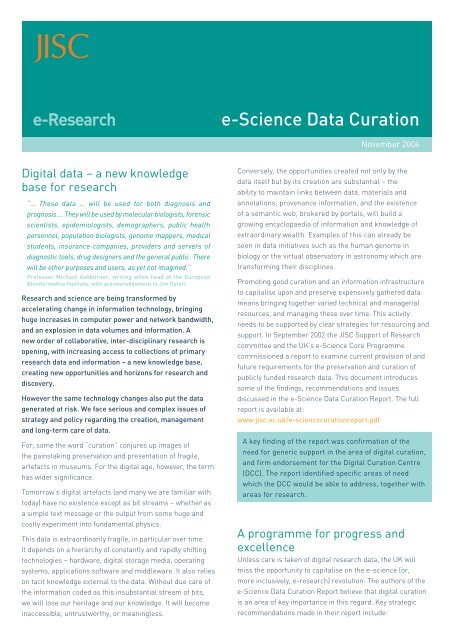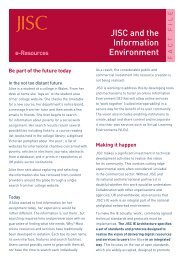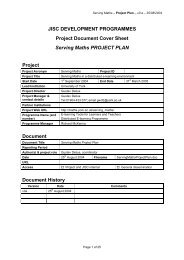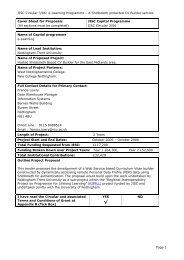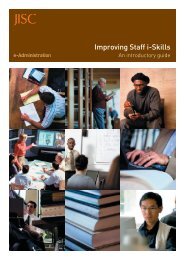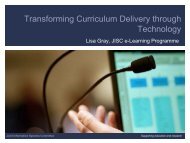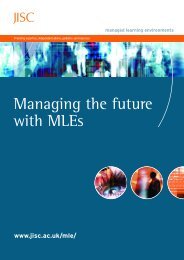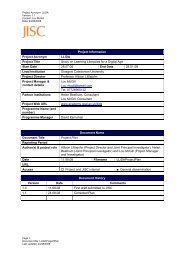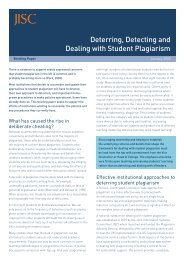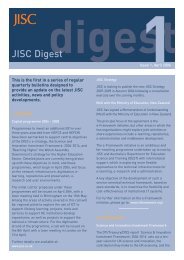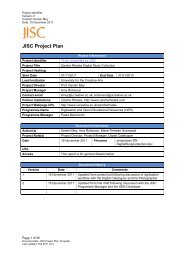e-Science Data Curation - Jisc
e-Science Data Curation - Jisc
e-Science Data Curation - Jisc
Create successful ePaper yourself
Turn your PDF publications into a flip-book with our unique Google optimized e-Paper software.
e-<strong>Science</strong> <strong>Data</strong> <strong>Curation</strong><br />
November 2004<br />
Digital data – a new knowledge<br />
base for research<br />
“… These data … will be used for both diagnosis and<br />
prognosis.… They will be used by molecular biologists, forensic<br />
scientists, epidemiologists, demographers, public health<br />
personnel, population biologists, genome mappers, medical<br />
students, insurance companies, providers and servers of<br />
diagnostic tools, drug designers and the general public. There<br />
will be other purposes and users, as yet not imagined.”<br />
Professor Michael Ashburner, writing when head of the European<br />
Bioinformatics Institute, with acknowledgement to Jim Ostell.<br />
Research and science are being transformed by<br />
accelerating change in information technology, bringing<br />
huge increases in computer power and network bandwidth,<br />
and an explosion in data volumes and information. A<br />
new order of collaborative, inter-disciplinary research is<br />
opening, with increasing access to collections of primary<br />
research data and information – a new knowledge base,<br />
creating new opportunities and horizons for research and<br />
discovery.<br />
However the same technology changes also put the data<br />
generated at risk. We face serious and complex issues of<br />
strategy and policy regarding the creation, management<br />
and long-term care of data.<br />
For, some the word “curation” conjures up images of<br />
the painstaking preservation and presentation of fragile,<br />
artefacts in museums. For the digital age, however, the term<br />
has wider significance.<br />
Tomorrow’s digital artefacts (and many we are familiar with<br />
today) have no existence except as bit streams – whether as<br />
a simple text message or the output from some huge and<br />
costly experiment into fundamental physics.<br />
This data is extraordinarily fragile, in particular over time.<br />
It depends on a hierarchy of constantly and rapidly shifting<br />
technologies – hardware, digital storage media, operating<br />
systems, applications software and middleware. It also relies<br />
on tacit knowledge external to the data. Without due care of<br />
the information coded as this insubstantial stream of bits,<br />
we will lose our heritage and our knowledge. It will become<br />
inaccessible, untrustworthy, or meaningless.<br />
Conversely, the opportunities created not only by the<br />
data itself but by its creation are substantial – the<br />
ability to maintain links between data, materials and<br />
annotations, provenance information, and the existence<br />
of a semantic web, brokered by portals, will build a<br />
growing encyclopaedia of information and knowledge of<br />
extraordinary wealth. Examples of this can already be<br />
seen in data initiatives such as the human genome in<br />
biology or the virtual observatory in astronomy which are<br />
transforming their disciplines.<br />
Promoting good curation and an information infrastructure<br />
to capitalise upon and preserve expensively gathered data<br />
means bringing together varied technical and managerial<br />
resources, and managing these over time. This activity<br />
needs to be supported by clear strategies for resourcing and<br />
support. In September 2002 the JISC Support of Research<br />
committee and the UK’s e-<strong>Science</strong> Core Programme<br />
commissioned a report to examine current provision of and<br />
future requirements for the preservation and curation of<br />
publicly funded research data. This document introduces<br />
some of the findings, recommendations and issues<br />
discussed in the e-<strong>Science</strong> <strong>Data</strong> <strong>Curation</strong> Report. The full<br />
report is available at:<br />
www.jisc.ac.uk/e-sciencecurationreport.pdf<br />
A key finding of the report was confirmation of the<br />
need for generic support in the area of digital curation,<br />
and firm endorsement for the Digital <strong>Curation</strong> Centre<br />
(DCC). The report identified specific areas of need<br />
which the DCC would be able to address, together with<br />
areas for research.<br />
A programme for progress and<br />
excellence<br />
Unless care is taken of digital research data, the UK will<br />
miss the opportunity to capitalise on the e-science (or,<br />
more inclusively, e-research) revolution. The authors of the<br />
e-<strong>Science</strong> <strong>Data</strong> <strong>Curation</strong> Report believe that digital curation<br />
is an area of key importance in this regard. Key strategic<br />
recommendations made in their report include:
e-<strong>Science</strong> <strong>Data</strong> <strong>Curation</strong><br />
November 2004<br />
Strategic recommendations<br />
1 Strategic-level advocacy for data curation is needed<br />
and should be assigned to a respected and influential<br />
champion so that strategic objectives are clearly<br />
articulated, to set the UK’s curation agenda over the<br />
medium term, and to enhance the UK’s standing,<br />
contribution and opportunities in this area.<br />
2 A curation task force made up of curation experts,<br />
practising researchers and research administrators<br />
should be established to inform and guide this agenda.<br />
This task force should work closely with and inform<br />
the work of the new UK Digital <strong>Curation</strong> Centre.<br />
3 The mismatch of short-term funding against the<br />
long-term needs for data retention needs to be<br />
addressed by providing new specific, long-term<br />
funding stream(s) for data centres and curation, thus<br />
ensuring that there is a strategic approach to data<br />
stewardship which addresses holding information<br />
indefinitely, makes it widely available and encourages<br />
cross-disciplinary usage, including linking to other<br />
digital information.<br />
4 Funding bodies should consider supporting researchled<br />
exemplars of curation to demonstrate and<br />
promote the benefits of curation for new research.<br />
5 Endorsement of the need for the Digital <strong>Curation</strong><br />
Centre.<br />
6 Criteria need to be established to determine what<br />
data we should keep, why and what level of curation<br />
is appropriate, together with mechanisms to monitor,<br />
validate and to modify them with accumulating<br />
experience.<br />
7 A programme of activities, both national and<br />
international, should be initiated to promote<br />
incentives which will foster a scientific culture of<br />
engagement in data care.<br />
8 Educational materials, guidelines and policy<br />
documents for researchers need to be developed and<br />
publicised.<br />
9 There should be increased investment, knowledge<br />
transfer, and cross-sector partnerships with<br />
knowledge-based and science and engineering<br />
industries to capitalise on UK expertise in data<br />
curation. This should be led by the DTI.<br />
10 Investment should be strengthened in those areas of<br />
curation research which will enhance data re-use: in<br />
particular we recommend focusing on those areas<br />
of research needed to establish trust in curated<br />
information.<br />
Where we are now<br />
Current provision for the archiving and curation of publicly<br />
funded research data is distributed among university-based<br />
centres, units operating within the Research Councils, and<br />
organisations attached to international research bodies.<br />
The report found that the funding for repositories, archive<br />
services and related research was generally short-term<br />
in nature and had to compete with research projects<br />
The UK’s e-<strong>Science</strong> Core Programme and the Research<br />
Councils, however, have funded and are funding a number<br />
of relevant projects which will support data curation, data<br />
preservation and data access.<br />
In early 2004 an award of £1.3 million per annum over<br />
three years was made by JISC and the UK e-<strong>Science</strong> Core<br />
Programme to a consortium headed by the University of<br />
Edinburgh, with the University of Glasgow, UKOLN and the<br />
Council for the Central Laboratory of the Research Councils,<br />
for the establishment of the Digital <strong>Curation</strong> Centre.<br />
The Digital <strong>Curation</strong> Centre aims to promote expertise<br />
and good practice, both national and international, for the<br />
management of all research outputs in digital format. The<br />
Digital <strong>Curation</strong> Centre will also provide a national focus for<br />
research into curation. The Digital <strong>Curation</strong> Centre itself will<br />
not be a data repository but will work with existing centres<br />
such as the Natural Environment Research Council data<br />
centres and institutional repositories. Substantial work,<br />
however, remains to be done by institutions and funders to<br />
develop the emerging information infrastructure.<br />
The Government has recently outlined its <strong>Science</strong> and<br />
Innovation Investment Framework 2004-2014. This has<br />
recognised the importance of the information infrastructure<br />
for science and states:<br />
“The growing UK research base must have ready and efficient<br />
access to information of all kinds – such as experimental<br />
data sets, journals, theses, conference proceedings and<br />
patents. This is the life blood of research and innovation.<br />
Much of this type of information is now, and increasingly, in<br />
digital form. This is excellent for rapid access but presents<br />
a number of potential risks and challenges. For example,<br />
the digital information from the last 15 years is in various<br />
formats (versions of software and storage media) that<br />
are already obsolete or risk being so in the future. Digital<br />
information is also often transient in nature, especially<br />
when published formally or informally on websites; unless<br />
it is collected and archived it will disappear. There are other<br />
challenges too, navigating vast online data/information<br />
resources determining the provenance and quality of the<br />
information, and wider issues of security and access.”<br />
<strong>Science</strong> and Innovation Investment Framework 2004-2014, H.M.<br />
Treasury (2004)
Development of the Digital <strong>Curation</strong> Centre and<br />
implementation of the other strategic recommendations<br />
in the e-<strong>Science</strong> <strong>Data</strong> <strong>Curation</strong> Report will be critical to<br />
achieving this vision and addressing the challenges and<br />
opportunities identified by the <strong>Science</strong> and Innovation<br />
Investment Framework.<br />
Defining curation<br />
Traditionally, curation is not only concerned with long-term<br />
care of books, paintings or other artefacts. It is also about<br />
maintaining their integrity and enabling and promoting<br />
their availability to appropriate audiences. The same is<br />
true for data. For data to remain useful, it may also need<br />
maintenance and enhancement. These, with the promotion<br />
of data to potential consumers, are two of the key roles<br />
of data curation. <strong>Curation</strong> also requires the skills of the<br />
archivist to ensure the data’s continuing safe custody: as<br />
part of that, the data needs to be preserved against changes<br />
in technologies which will make the data inaccessible or<br />
meaningless.<br />
The e-<strong>Science</strong> <strong>Curation</strong> report differentiated digital<br />
curation from archiving and preservation as follows:<br />
<strong>Curation</strong>: The activity of managing and promoting the<br />
use of data from its point of creation, to ensure it is fit for<br />
contemporary purpose, and available for discovery and<br />
re-use. For dynamic datasets this may mean continuous<br />
enrichment or updating to keep it fit for purpose.<br />
Archiving: A curation activity which ensures that data is<br />
properly selected, stored, can be accessed and that its<br />
logical and physical integrity is maintained over time,<br />
including security and authenticity.<br />
Preservation: An archiving activity in which specific items<br />
of data are maintained over time so that they can still be<br />
accessed and understood through successive change and<br />
obsolescence of technologies.<br />
Why keep data?<br />
Underlying the phrase “data curation” is an assumption that<br />
data has value. In addition to the public accountability for<br />
and access to the outputs of publicly funded research, the e-<br />
<strong>Science</strong> <strong>Data</strong> <strong>Curation</strong> Report identified seven major reasons<br />
to keep data:<br />
■ Re-use of data for new research, including collectionbased<br />
research to generate new science<br />
■ Retention of unique observational data which is<br />
impossible to re-create<br />
■ Retention of expensively generated data which is cheaper<br />
to maintain than to re-generate<br />
■ Enhancing existing data available for research projects<br />
■ For compliance with legal requirements<br />
■ To validate published research results<br />
■ For use in teaching<br />
When asked about the value of digital data, the publicly<br />
funded UK researchers surveyed, said 79% of primary<br />
data and 94% of published data is of value at project end.<br />
Aspects of curation<br />
The data revolution raises many issues of trust which must<br />
be addressed before data-based research can flourish<br />
– issues of security, confidentiality, ownership, assured<br />
provenance, authenticity, as well as the quality of the data<br />
and the metadata (the data about the data). Whilst practice<br />
and experience in curation are increasing rapidly, areas of<br />
curation are still in a research and proof-of-concept phase.<br />
Much research and practical and exploratory activity is<br />
being undertaken in the UK, of world-class quality. Areas for<br />
further research, debate and action include:<br />
■ Trust: Will a calculation today give the same result made<br />
on an older computer architecture? Was the original<br />
data correct? Is it still an authentic copy? The greater the<br />
confidence we have in the data, the more we are likely<br />
to use it, and vice versa. Trust can be enhanced by the<br />
existence of qualified domain specialists who curate the<br />
data. The more the data is used, the better the return on<br />
investment; the higher the quality of the data, the lower<br />
the risk.<br />
■ Utility: As well as confidence that the data has<br />
maintained its integrity, we need certain information<br />
about the data – where it came from, how it was<br />
generated, for example – to enable future users to gauge<br />
the utility and reliability of the data, and indeed any<br />
annotation of the data. <strong>Data</strong> utility also depends on the<br />
ability of users to manage and analyse it; data mining<br />
tools and algorithms, visualisation tools, user interfaces<br />
and portals will play a crucial role in accelerating<br />
research.<br />
■ Discoverability: How will future users find data, in<br />
particular data they do not know exists, in other domains,<br />
or archived according to terminology which has fallen out<br />
of use? <strong>Data</strong> access is often organised through portals;<br />
how will those portals be organised? What tools will<br />
users need to read or use the data, and who will provide<br />
these tools?<br />
■ Access management: A significant proportion of data<br />
involves confidentiality issues. Ownership and rights<br />
management also need to be taken into account. These<br />
access questions can be particularly difficult across
e-<strong>Science</strong> <strong>Data</strong> <strong>Curation</strong><br />
November 2004<br />
national boundaries. All these aspects must be respected<br />
and managed as part of the data curation.<br />
■ Selection: What criteria should be applied when selecting<br />
data for longer-term retention? How do we know what we<br />
should keep? Who sets the selection criteria? How can<br />
selection be assessed, when, how often, by whom? Or<br />
should we keep everything?<br />
■ Heterogeneity: Not only is this data revolution creating<br />
a deluge of data, the data itself comes in very many<br />
different and often specialist formats, some created by<br />
the researchers themselves.<br />
■ Complexity: The data can be composite in nature, with<br />
links to external objects and external dependencies<br />
(such as calibration information), and be highly complex<br />
in structure. This complexity represents a significant<br />
challenge for the preservation of data.<br />
The work being carried out and the tools being developed,<br />
such as those in the e-science projects, will contribute to the<br />
practicality, economics and thus viability of data curation.<br />
This work is also important for funders: on the one hand it<br />
lightens the cost burden entailed in keeping data, and on the<br />
other it can protect the value of data generated in research.<br />
Good data management practices on the part of users will<br />
reduce the burden of work required for preservation and<br />
curation, and also for the acquisition of the data at the stage<br />
it enters a repository. While guidance is extremely important,<br />
this management will consume some resources by those<br />
generating data, and this needs to be reflected in funding.<br />
Again, tools which facilitate and encourage this process will<br />
mean that less funding is needed and a greater degree of<br />
compliance on the part of the user.<br />
Organisational model<br />
The diagram below provides a simplified model for data<br />
curation in the UK.<br />
Viewed on the left is the data producer domain, where<br />
scientists and research workers in their various institutions<br />
create data, and who will submit this data to organisations<br />
providing curation services, shown in the centre column.<br />
<strong>Data</strong> curated within this curation domain will be accessed<br />
by researchers and others (consumers), as shown on the<br />
right. Initially consumers may be contemporaneous with<br />
the submitters, but eventually will be separated from the<br />
producers by many years.<br />
Producer and consumer communities are seen as operating<br />
locally in their institutions, research groups or units. Some<br />
curation services will be best provided at this level too, whether<br />
related to the content of data (and therefore in general related<br />
to specific disciplines) or its physical management and storage.<br />
In other cases it might be better to provide such services in<br />
a distributed fashion – perhaps serving many users within a<br />
single discipline spread across different institutions. Other<br />
curation services might be more efficient if provided centrally,<br />
particularly those shared across communities. An example<br />
is the provision of tools to manage the preservation of data<br />
held in very common software formats.<br />
Acknowledgements<br />
The e-<strong>Science</strong> <strong>Curation</strong> Report and this summary were prepared<br />
by Philip Lord and Alison Macdonald of the Digital Archiving<br />
Consultancy. The authors wish to acknowledge the significant<br />
contribution made by Neil Beagrie, leader of the steering committee<br />
for the report, Dr. David Boyd, Fred Hopper and Professor Alan<br />
Rector of the report steering committee, and Professor Tony Hey.<br />
PRODUCER DOMAIN CURATION DOMAIN CONSUMER DOMAIN<br />
Central provision<br />
Generic support services<br />
(Tools, format registries, technology watches etc.)<br />
Discipline-related<br />
services<br />
Storage services<br />
Distributed provision<br />
Discipline A<br />
Discipline B<br />
Discipline C<br />
Local provision<br />
Scientists/<br />
researchers<br />
Submission<br />
Delivery<br />
Scientists/<br />
researchers<br />
Key:<br />
= Major communication path<br />
= Less important communication path


